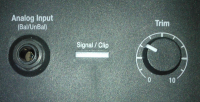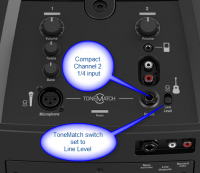Balanced vs Unbalanced
Contents
Terminology
Stereo, Mono, Balanced, Unbalanced are terms that refer to applications (how a cable is being used).
XLR, Tip-Ring-Sleeve, Tip-Sleeve are terms that refer to connections (the physical connectors at the ends of the wires and how those wires are attached to the connectors).
One source of confusion is that a cable with a ¼ inch jack Tip-Ring-Sleeve jack on one end may be used for several applications (examples)
- stereo headphones (left and right sides of a stereo signal)
- mono balanced connection (hot and cold signals)
- insert (send and return)
Whether or not a cable with a ¼ inch jack Tip-Ring-Sleeve jack is stereo/mono/insert depends on how it is being used and the electronic interfaces at both ends of the connection.
Connections to Bose L1 Systems
T1 ToneMatch Audio Engine
- Channels 1,2,3 XLR inputs are balanced.
- Channels 1,2,3 1/4" jacks are unbalanced (but will accept ¼ inch jack Tip-Ring-Sleeve) the connections are still unbalanced.
- Channels 4/5 are balanced, but will accept ¼ inch jack Tip-Sleeve.
If you use a ¼ inch jack Tip-Ring-Sleeve from a balanced source, the connection will be balanced.
If you use a ¼ inch jack Tip-Ring-Sleeve from an unbalanced source, the connection will be unbalanced.
If you use a ¼ inch jack Tip-Sleeve from a balanced or unbalanced source, the connection will be unbalanced.
If you have a balanced source then using a balanced connection (XLR or ¼ inch jack Tip-Ring-Sleeve) is preferable.
L1 Model II
- Model II Power Stand Analog input is balanced.
It will accept ¼ inch jack Tip-Sleeve.
If you use a ¼ inch jack Tip-Ring-Sleeve from a balanced source, the connection will be balanced.
If you use a ¼ inch jack Tip-Ring-Sleeve from an unbalanced source, the connection will be unbalanced.
If you use a ¼ inch jack Tip-Sleeve from a balanced or unbalanced source, the connection will be unbalanced.
If you have a balanced source then using a balanced connection (XLR or ¼ inch jack Tip-Ring-Sleeve) is preferable.
L1 Model 1S
- Model II Power Stand Analog input is balanced.
It will accept ¼ inch jack Tip-Sleeve.
If you use a ¼ inch jack Tip-Ring-Sleeve from a balanced source, the connection will be balanced.
If you use a ¼ inch jack Tip-Ring-Sleeve from an unbalanced source, the connection will be unbalanced.
If you use a ¼ inch jack Tip-Sleeve from a balanced or unbalanced source, the connection will be unbalanced.
If you have a balanced source then using a balanced connection (XLR or ¼ inch jack Tip-Ring-Sleeve) is preferable.
L1 Compact
Compact Channel 2 1/4" jack input is balanced.
It will accept ¼ inch jack Tip-Sleeve.
If you use a ¼ inch jack Tip-Ring-Sleeve from a balanced source, the connection will be balanced.
If you use a ¼ inch jack Tip-Ring-Sleeve from an unbalanced source, the connection will be unbalanced.
If you use a ¼ inch jack Tip-Sleeve from a balanced or unbalanced source, the connection will be unbalanced.
If you have a balanced source then using a balanced connection (XLR or ¼ inch jack Tip-Ring-Sleeve) is preferable.
References
Balanced vs. Unbalanced Cables - Sweetwater
Unbalanced vs. Balanced Lines - Whirlwind
Interconnection of Balanced and Unbalanced Equipment Bill Whitlock, Jensen Transformers.
Sound System Interconnection RaneNote 110
Balanced, Unbalanced, Stereo? what are they? Sweetwater.com > Frequently Asked Questions
Balanced vs Unbalanced Interconnects audioholics.com


